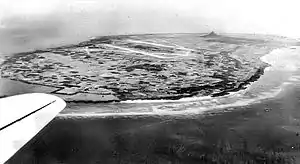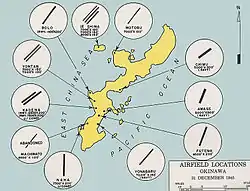Ie Shima Airfield
Ie Shima Auxiliary Airfield (伊江島補助飛行場, Iejima Hojo Hikōjō) is a training facility, managed by the United States Marine Corps and a former World War II airfield complex on Ie Shima, an island located off the northwest coast of Okinawa Island in the East China Sea. The airfield as such was inactivated after 1946 but part of the former airfield is still used as a training facility for parachute drops and vertical take off and landing aircraft such as the F-35. The facility is referenced as FAC6005 by Okinawa Prefecture.
| Ie Shima Airfield 伊江島補助飛行場 | |
|---|---|
| Ie Shima, Ryukyu Islands, Japan | |
 Aerial photo of Ie Shima Island, off the northwest coast of Okinawa, 1945 looking east over the 77th Division landing beaches, toward the Pinnacle. | |
| Coordinates | 26°43′23.20″N 127°46′40.78″E |
| Type | Military airfield Complex |
| Site information | |
| Controlled by | United States Marine Corps |
| Site history | |
| Built | Prior to April 1945 |
| In use | 1945-1946 |
History
Invasion and construction

The airfields on Ie Shima were built by the Japanese prior to the American invasion and subsequent Battle of Okinawa in April 1945. It was seized by elements of the United States Army 77th Infantry Division after intermittent bombardment of the island by the United States Navy Fifth Fleet from 25 March through 16 April when the invasion of the island commenced. The island was not declared secure until 24 April.
Prior to the invasion, the Japanese commander on Okinawa, believing that Ie Shima could not be held for more than a few days, ordered that the airfields on the island be destroyed by the end of March 1945. Thorough demolitions followed. The runways were ditched and blasted and the entire central area sown with mines, as defense against possible airborne attack. The airfields were also mined by unused aerial bombs and mines made from drums of gasoline.
Base development proceeded rapidly once the mopping up was completed. Although initially delayed by the large number of mines, soldiers from the 805th Engineer Aviation Battalion, 1892nd Engineer Aviation Battalion, the 1902nd and the 1903rd Engineer Aviation Battalions, and several other engineering units quickly repaired the enemy airfields and began the construction of new runways, along with a series of interlinking taxiways, revetments, maintenance facilities along with a containment facility for personnel. The coral foundation of the island and the rubble of the town of Ie facilitated the work. There was ample room for dispersal area, and the sloping ground on the sides and ends of the central plateau provided space for housing base personnel. Japanese civilians were evacuated to Tokashiki in the Kerama Islands. Engineers discovered a large limestone basin on the north coast which produced 100,000 gallons of fresh water. Under these conditions work proceeded rapidly and by 10 May one fighter group was based on the island. By the middle of the month three runways were ready for operational use along with taxiways. In addition, radar and air warning facilities installed, although much construction work remained.
Operational units assigned
By 14 June three fighter groups and one night fighter squadron were operating from the airfield. As expected, Ie Shima proved to be an ideal base for the support of operations on Okinawa and for preparing later attacks on the Japanese homeland.
|
|
Japanese Surrender Delegation
On 19 August 1945, two B-25Js of the 345th Bombardment Group and 80th Fighter Squadron P-38 Lightnings escorted two Japanese Mitsubishi G4M "Betty" bombers. The Japanese aircraft carried a delegation from Tokyo en route to Manila to meet General MacArthur's staff to work out details of the surrender.
The Betty bombers were painted white with green crosses on the wings, fuselage and vertical tail surface and use the call signs Bataan I and Bataan II. After the delegation landed at Ie Shima, they boarded a C-54 Skymaster and were flown to Manila. After the meeting, they returned to Ie Shima. One of the two Bettys crashed on its way back to Japan out of fuel, due to an incorrect conversion of liters to gallons when the bombers were refueled. The crew were helped by a local fisherman, and returned to Tokyo by train.
Postwar use
With the end of the war, many of the units assigned to Ie Shima were reassigned or inactivated. By the end of 1946, the facility was closed and placed in reserve status. The American military still controlled roughly one third of the island in 2010.[1] As of May 2019, according to the "Ie Island Guide Map" posted at the ferry landing, the American Military controls roughly 15% of the island as the "Ie Shima Training Facility," used primarily by the U.S. Marine Corps.
In the late 1950s the air station was used as a bomb gunnery range.
In March 1955, occurred what has been called the second Invasion of the island by the American military.[1][2][3] After the expropriation of their lands and houses at gun-point,[1] many local farmers were injured when trying pick up spent cartridges left by aircraft performing gunnery practice.[1]
There were two Air Force units stationed on the island in the early 1960s. One was Detachment 1, 1962nd Communications Group which operated a radio receiver site. The other was a unit responsible for operating the 18th Tactical Fighter Wing's bomb gunnery range on the island. Although small, the base looked much like a full-fledged base which included barracks, mess hall, fire department, security guards and guard dogs, a small motor pool and even a Non-Commissioned Officers Club. Although the air force station had a usable runway which was occasionally used, transport of personnel and supplies to the island was on the local civilian ferry from Motobu Port on Okinawa.
In 1963 the island experienced a severe drought. For a while all the water wells on the island except for one dried up. That one well was on airfield property controlled by the U.S. Air Force. The officer in charge dispatched his fire department personnel to use the station's pumper truck to pick up water at the well and to distribute the water to several locations on the island. As a result, Air Force officials on Ie Shima and Okinawa received several letters of appreciation from local officials.
Current use
The three runways that were in use when World War II ended still exist. The United States military maintains the western runway as a small unimproved 5,000-foot (1,500 m) coral runway. It also has a simulated LHA deck, and a drop zone for parachute training, being part of a military training facility operated by the United States Marine Corps. There is a detachment of usually less than 20 Marines which operates the range. F-35 operations have been conducted at the USMC facility. An admin and housing facility for personnel has been built at the Northern end of the derelict middle airstrip.
The eastern runway is now Iejima Airport and is used by a small civilian air carrier, and the central one is now abandoned and is used as a thoroughfare for residents to get from the north to the south side of the island.
The Simulated LHA deck is used by Marine Wing Support Squadron 172 Marine Aircraft Group 36. The coral runway is also still in use for touch and go operations.
The Iejima Light House is located within the U.S. military fence line at the southwest end of the island. The U.S. Marine Corps, along with the Japan Coast Guard, periodically hosts a memorial ceremony for the light keeper killed during the battle of Ie Shima in WWII.
Notes
- Journal, The Asia Pacific. "Beggars' Belief: The Farmers' Resistance Movement on Iejima Island, Okinawa—— | The Asia-Pacific Journal: Japan Focus". apjjf.org. Retrieved 31 August 2018.
- Journal, The Asia Pacific. "I Lost My Only Son in the War: Prelude to the Okinawan Anti-Base Movement—— | The Asia-Pacific Journal: Japan Focus". apjjf.org. Retrieved 31 August 2018.
- Mitchell, Jon (22 May 2011). "Iejima: an island of resistance". The Japan Times Online. ISSN 0447-5763. Retrieved 31 August 2018.
References
![]() This article incorporates public domain material from the Air Force Historical Research Agency website http://www.afhra.af.mil/.
This article incorporates public domain material from the Air Force Historical Research Agency website http://www.afhra.af.mil/.
- Maurer, Maurer (1983). Air Force Combat Units Of World War II. Maxwell AFB, Alabama: Office of Air Force History. ISBN 0-89201-092-4.
- www.pacificwrecks.com
- The Battle for Ie Shima
- The True Story of the Japanese Surrender in WW2
- A Closer Look at the Japanese Betty Bombers
- The 34th Fighter Squadron on Ie Shima
- Research the Battle of Okinawa Here
- National Archives at College Park, Maryland, microfiche Roll #A0290, slides 0388 to 0532, history of the 1892nd Engineer Aviation Battalion
.svg.png.webp)
.svg.png.webp)
.png.webp)